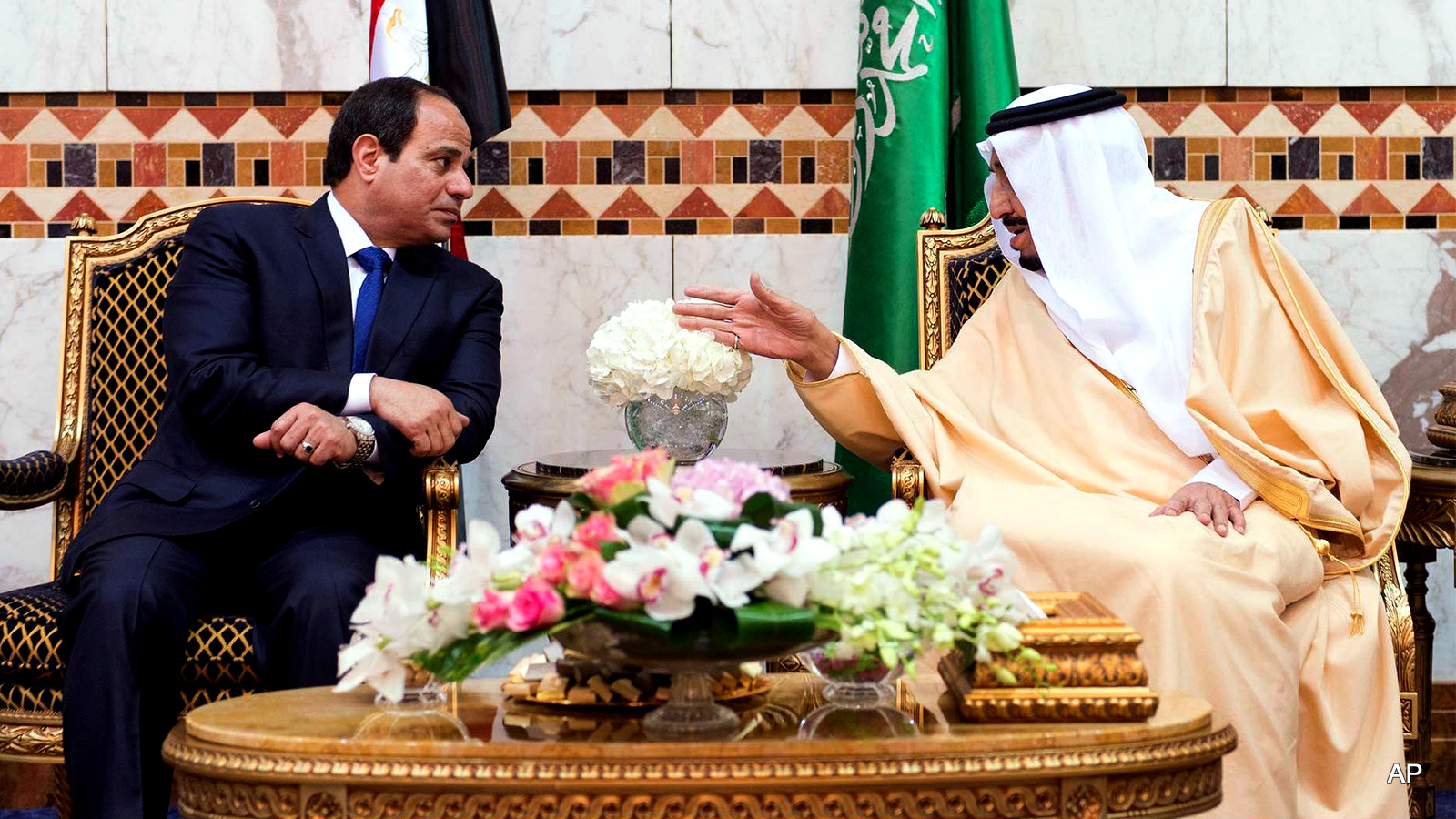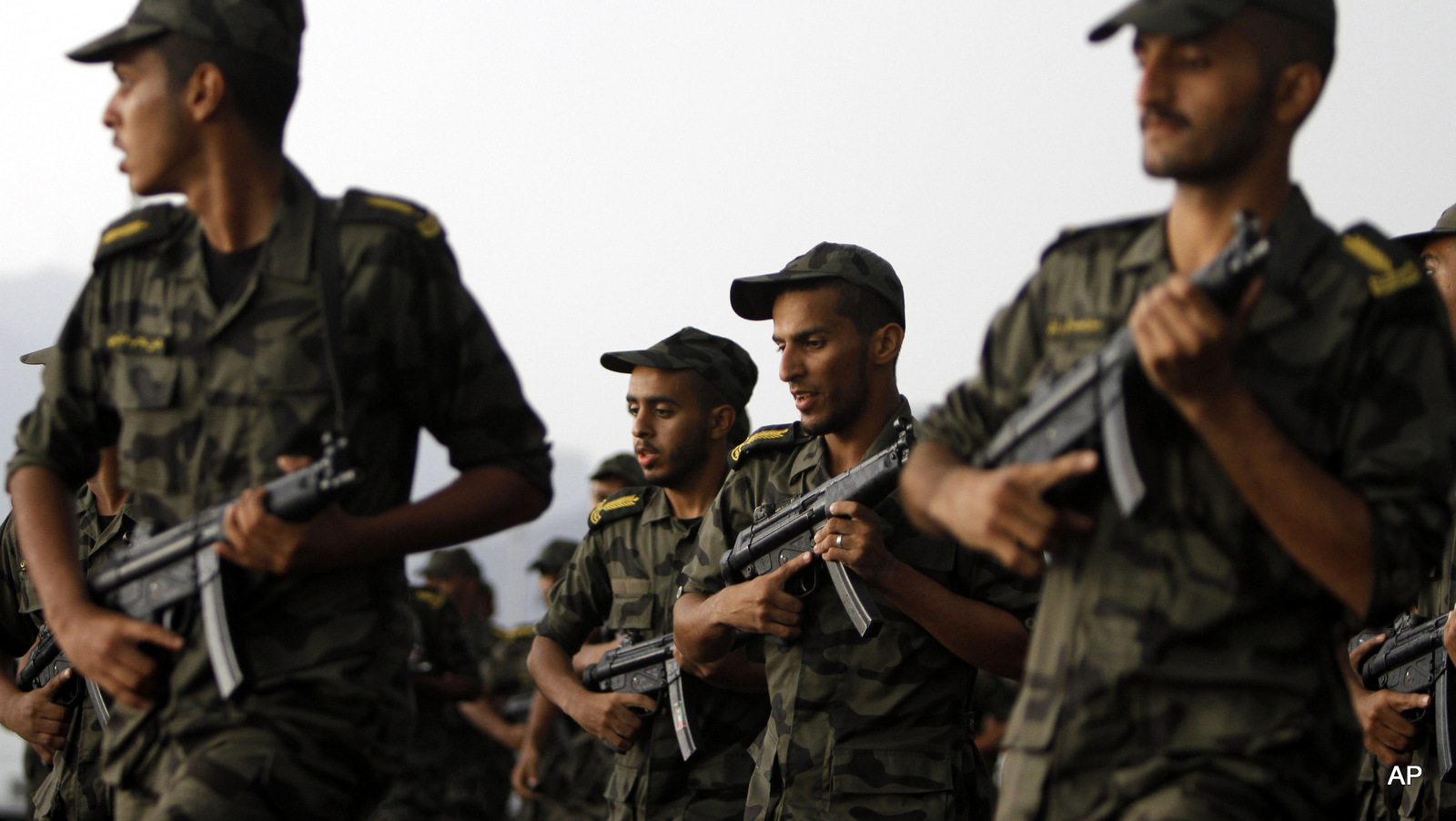 Saudi King Salman, right, meets with Egyptian President Abdel-Fattah el-Sissi upon his arrival to Riyadh Airbase, Riyadh, Saudi Arabia, Sunday, March 1, 2015. El-Sissi visited Saudi Arabia on Sunday for his first policy meeting with the country’s king
Saudi King Salman, right, meets with Egyptian President Abdel-Fattah el-Sissi upon his arrival to Riyadh Airbase, Riyadh, Saudi Arabia, Sunday, March 1, 2015. El-Sissi visited Saudi Arabia on Sunday for his first policy meeting with the country’s king
BEIRUT — News media has been lighting up with speculation about a pan-Arab army, proposed by Egypt and supported by Gulf state rulers, to contain the threat of the Islamic State of Iraq and Syria (ISIS).
“There is an urgent need for the creation of a multi-purpose common Arab military force… able to intervene rapidly to fight terrorism and the activities of terrorist groups,” Nabil Elaraby, secretary-general of the Arab League and former Egyptian foreign minister, declared on March 9.
Speaking at an Arab League meeting in Cairo, his statement was in reaction to news that 20 Egyptian Coptic Christians and one citizen of Chad had been beheaded by ISIS in Libya in February.
Yet the likelihood of such a force being created in the near future is extremely improbable, according to Hilal Khashan, chair of the Political Science Department at the American University of Beirut. He identified the two main obstacles to Elaraby’s proposal as disunity among Gulf Arab states and a lack of support from the United States.
“The Arabs have never displayed a long-term ability for cooperation,” Khashan told MintPress News in an email. “Arabs need U.S. endorsement before creating such a force. It is highly unlikely that the U.S. wants Arabs to operate independently of its plans for the region.”
What would a pan-Arab army look like?
 Saudi soldiers exercise before a military parade at a military camp in Arafat, Saudi Arabia, Wednesday, Oct. 9, 2013.
Saudi soldiers exercise before a military parade at a military camp in Arafat, Saudi Arabia, Wednesday, Oct. 9, 2013.
If created, the army would include Egypt, Saudi Arabia, Jordan and the United Arab Emirates (UAE) — states that have all supported the idea of its creation in recent months.
According to Khashan, Saudi Arabia first proposed the idea for such a force. The kingdom would also be the main financial backer for such an army and, therefore, lead it as well. The majority of the troops and personnel would come from Egypt “almost exclusively,” explained Khashan. Egypt has the largest standing army in the Middle East and among the states that support the force’s creation.
According to Khashan, Saudi Arabia has stated that it would provide 100,000 troops. He is skeptical about this coming to fruition, though, because the “Saudi army is not a fighting army.”
The threat ISIS poses to Saudi Arabia and some of its Gulf neighbors, including Qatar, could be seen as ironic in that the group may have received support from private donors in Gulf countries in the past.
Sir Richard Dearlove, chief of the British Secret Intelligence Service (MI6) from 1999 to 2004, lends credence to this theory. Speaking at the Royal United Services Institute, a think tank based in London, on July 7, 2014, Dearlove said, “For ISIS to be able to surge into the Sunni areas of Iraq in the way it has done recently has to be the consequence of substantial and sustained funding: such things simply do not happen spontaneously.”
“How much Saudi and Qatari money – now I’m not suggesting direct government funding, but I am suggesting maybe a blind eye being turned – is being channeled towards ISIS, and reaching it?” he continued.
Patrick Cockburn, Middle East correspondent for The Independent and author of “The Rise of Islamic State: ISIS and the New Sunni Revolution,” backed up Dearlove’s statement almost a week later, writing, “This sounds realistic since the tribal and communal leadership in Sunni majority provinces is much beholden to Saudi and Gulf paymasters, and would be unlikely to cooperate with Isis without their consent.” Saudi Arabia has categorically denied the accusations.
However, Cockburn also highlighted that support for ISIS is not likely an official Saudi state policy, and support from the state comes inadvertently through its assistance to other groups opposed to ISIS.
“By seeking to weaken Maliki and Assad in the interest of a more moderate Sunni faction, Saudi Arabia and its allies are in practice playing into the hands of Isis which is swiftly gaining full control of the Sunni opposition in Syria and Iraq,” he wrote.
Lebanon as precedent
 Members of the Arab Deterrent Force, Beirut, 1977.
Members of the Arab Deterrent Force, Beirut, 1977.
The original idea for such a force derived from “an Arab Deterrent Force (ADF) to restore peace to Lebanon” in 1976, Khashan explained to MintPress.
The Arab League created the ADF that year, on the heels of Syria’s invasion of Lebanon in June following the outbreak of war in the Mediterranean country. Syria entered Lebanon after realizing that “partition [of the country] might constitute a threat to its position and undermine its influence on Lebanese affairs,” according to Jean Pierre Issele of the University of Geneva and author of “The Arab Deterrent Force in Lebanon.” The predominantly Syrian force stayed in Lebanon until protests forced them out in 2005.
Problems preventing its creation
While there have been meetings between Gen. Abdel-Fattah el-Sissi, Egypt’s army chief and president, and King Salman of Saudi Arabia to discuss the possibility of creating this pan-Arab army, the plan faces insurmountable geopolitical and historical obstacles.
The first, as mentioned above, is that Arab League states, which include 21 countries in North Africa and Southwest Asia, do not have unified foreign policy goals to agree on how to use such a force.
Even among the Gulf Cooperation Council, which includes six countries — Bahrain, Kuwait, Oman, Qatar, Saudi Arabia, and the UAE — there are divergent views on regional policy. Khashan told MintPress, “Both the Arab League and the GCC have displayed perennial inability in making consequential decisions.”
This division is especially apparent in Qatar’s policies in the region compared with that of other GCC member states. Saudi Arabia and Qatar wrangled over the future of Egypt when the Muslim Brotherhood came to power in the country in 2012. Qatar ultimately lost in the struggle for influence with the state when el-Sissi came to power in 2013 after leading a military coup. He was supported by Saudi Arabia.
Further, Oman has always acted as a kind of outlier. Since the founding of the GCC in 1981, Oman has had close ties with the Islamic Republic of Iran, which other member states have looked on with disdain.
As for Egypt, Khashan noted that memories of disastrous adventurism abroad still weigh heavy on its psyche. Referring to the country’s foray into Yemen from 1962 to 1967, he explained, “They do not want to repeat the disaster of involvement in Yemen. This is the reason why forming such a force is not as easy as one might think.”
Egypt entered into Yemen’s civil war in 1962 on the side of the revolutionaries, who overthrew the Mutawakkilite Kingdom of North Yemen ruled by Imam Muhammad al-Badr. Egypt provided tens of thousands of troops to the effort, expending huge amounts of blood and treasure only to become trapped in a quagmire.
The debacle was so problematic for Egypt that it was later called “Egypt’s Vietnam.” With its strength squandered in Yemen, the debacle is also highlighted as a reason for Egypt’s tremendous failure in fighting Israel in 1967.
And finally, Khashan explained that one of the most debilitating problems for the potential force is its potential range of operations. “The Egyptians want to commit it to Libya, to which the Saudis are opposed. The Saudis want it to safeguard their northern borders against ISIS in Iraq and their southern borders to stop the Houthis in Yemen,” he explained.
The states are “plagued by mutual distrust,” Khashan asserted, ultimately concluding that “such a force is unrealistic.”
However, the potential for the creation of this army will be further illuminated later this week at the Arab League’s annual summit in Sharm el-Sheikh, Egypt, scheduled for March 28-29.
Arab League Deputy Chief Ahmed Ben Helli told reporters earlier this month that the proposed pan-Arab force would be discussed at the summit. He said, “Such forces should be ready and present so that they could symbolically show that the Arab countries have a deterrent force and a peacekeeping force that could step in at times of conflicts.”

